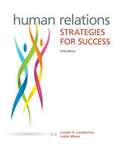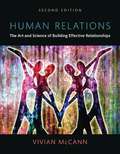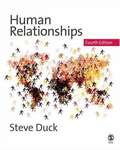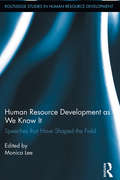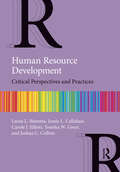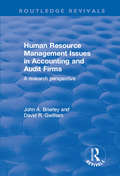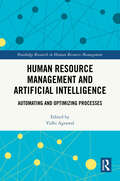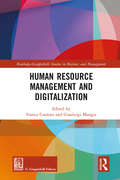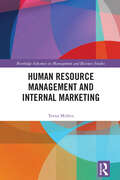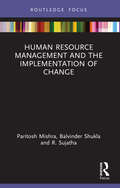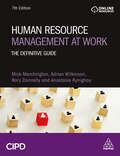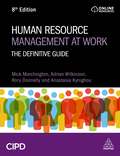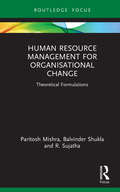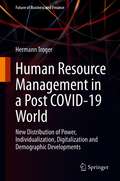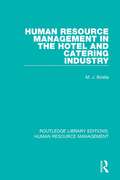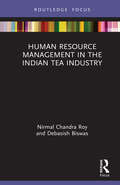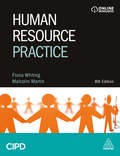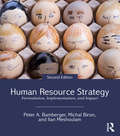- Table View
- List View
Human Relations: Strategies for Success
by Lowell H. Lamberton Leslie Minor-EvansWe believe strongly in the importance of understanding the relationship between self-esteem and human relations.
Human Relations: Strategies for Success (Fifth Edition)
by Leslie Minor-Evans Lowell LambertonHuman Relations: Strategies for Success 5e by Lowell Lamberton and Leslie Minor will help you prepare for this changing world. This text covers time-tested, research-based social science and management principles, as well as newer theories and philosophies of human relations drawn from management theory, group theory, personality theory, and relationship theory. More than ever, effective human relations skills are crucial to business success as organizations grow and compete in a global business environment. Employees must have the knowledge and skill to adapt to a workplace where change is frequent and inevitable. Their commitment to the creation of a book that is at once interesting to read, motivating to study, and relevant to a wide variety has been the driving force behind Human Relations: Strategies for Success.
Human Relations: The Art and Science of Building Effective Relationships (Second Edition)
by Vivian McCannFor courses in Adjustment, Interpersonal Behavior, and Human Relations. A conceptual and skills-based overview of relationship building in today’s world. Human Relations: The Art and Science of Building Effective Relationships helps students learn how to communicate more effectively within all of their personal and professional relationships. Employing a three-tiered approach to human relations, author Vivian McCann helps students to understand the psychological concepts that underlie relationships, to build the skills needed to communicate effectively, and to consider the influence of cultural norms and backgrounds throughout the relationship-building process. Revised to reflect the latest data and research, the Second Edition also includes updated information about how new technologies have greatly impacted today’s relationships.
Human Relationships (4th edition)
by Steve DuckThe Fourth Edition of this highly successful textbook provides a unique and comprehensive introduction to the study and understanding of human relationships. This thoroughly revised edition combines the most recent research from social, personality, and developmental psychology, communication studies, family studies, and sociology with greater interdisciplinarity coverage and emphasis on processes of everyday life. Fresh insights from family studies, developmental psychology, occupational, and organizational psychology also combine to bring new perspectives to this thorough survey of the field. Thoroughly updated, with new chapters on Relating Difficulty, "small media" technology and relationships, and practical applications, the new edition is responsive to the student demand for insight into their own lives.
Human Relationships (Relationships Ser.)
by Steve DuckThe Fourth Edition of this highly successful textbook provides a unique and comprehensive introduction to the study and understanding of human relationships. Fresh insights from family studies, developmental psychology, occupational and organizational psychology also combine to bring new perspectives to this thorough survey of the field. Thoroughly updated, with new chapters on: relating difficulty; "small media" technology and relationships, and practical applications, the Fourth Edition offers a fully up-to-date and authoritative review of the field.
Human Resource Development as We Know It: Speeches that Have Shaped the Field (Routledge Studies in Human Resource Development)
by Monica LeeThe field of Human Resource Development has developed largely through academics, scholars and reflective practitioners from across the world coming together. Many people link memorable keynote speeches to changes in their research, practice, career path or even life view. Good keynote speeches are a forthright statement of the expert’s view and thus are often not published. Now that HRD is maturing there is a need to recapture some of those earlier moments – both as a form of archive, and also to shed light on the path that has been followed. Twenty-two speeches seminal to the field of HRD are included in this volume. These speeches are milestones along the path of the development of the field; as well as reconstructing their speech, the contributors have also located it within the time it was given and commented on how the field has developed since. This book is a resource, not only as an archive and for those who wish to relive their pivotal moments, but also for anyone interested in the development of HRD as a discipline. This unique approach provides an exciting and engaging way to reflect on cutting edge issues in the academic and practitioner world of HRD!
Human Resource Development: Critical Perspectives and Practices
by Laura L. Bierema Joshua C. Collins Jamie L. Callahan Carole J. Elliott Tomika W. GreerHuman Resource Development: Critical Perspectives and Practices is a landmark textbook on HRD scholarship and practice and is a significant departure from the standard HRD texts available. Based on Bierema and Callahan’s framework for critical human resource development, this book develops an understanding of HRD that addresses both key and contested issues of practice associated with relating, learning, changing, and organizing for organizations. This book covers the basic tenets of HRD, interrogates the dominant paradigms and practices of the field, teaches readers how to critically assess HRD practices and outcomes, and provides critical alternatives. The text also addresses HRD as a contested field and the importance for HRD professionals to reflect on their values, maintain their sanity, and retain their employment while attempting to do this difficult work that serves multiple stakeholders. The text weaves in Points to Ponder, Case in Point, and Tips & Tools features and exercises, giving readers an insight into HRD issues across the globe. This critical text offers an exciting alternative to the instrumentalist, managerialist, and masculine perspective of other books. Designed for students and practitioners, this textbook will be essential reading for upper-level courses on human resource development, human resource management, and adult education.
Human Resource Management Issues in Accounting and Auditing Firms: A Research Perspective (Routledge Revivals)
by John A Brierley David GwilliamThis title was first published in 2001: Focusing on human resource management practices in the multinational multi-service providers, this text presents some complex academic research in an accessible form. This book collates and reviews, in a manner designed to be both accessible and comprehensible to the interested reader, the extensive body of academic literature which has been developed since the 1980s. In addition, it provides a perspective on human resource management issues, practices and problems based in part on interviews with senior personnel. Most suitable for scholars and practitioners of business and management, social policy/sociology and economics.
Human Resource Management Issues in Developing Countries (Routledge Revivals)
by Farhad AnalouiPublished in 1998, this work brings together 17 individual papers written by academics, practioners and consultants who have dealt with human resource issues in various contexts and developing countries. It covers management, education and training and through these addresses ethnic and gender issues, financial markets in transition economies and agricultural development. Countries featuring in the studies include Bangladesh, Ghana, Pakistan, and Costa Rica - and the authors draw on their own experiences in these countries.
Human Resource Management and Artificial Intelligence: Automating and Optimizing Processes (Routledge Research in Human Resource Management)
by Vidhi AgrawalThis edited volume undertakes an intellectual expedition aimed at elucidating the symbiotic relationship between Artificial Intelligence (AI) and the domain of Human Resource Management (HRM). Aligned with a forward-looking perspective, this scholarly work embarks on a comprehensive inquiry into the transformative capacities of AI within distinct HR functions, including but not limited to recruitment, performance evaluation, and employee development. As organizations embrace the transformative potential of AI, the book unfurls a roadmap that navigates the complexities of this transition. Insights into the metamorphosis of HRM practices, the recalibration of workforce dynamics, and the resultant organizational culture metamorphosis provide prescient guidance for stakeholders navigating the uncharted waters of AI adoption. Its overarching framework aspires to cultivate an environment conducive to intellectual discourse, offering a collaborative platform for academic scholars, research practitioners, industry experts, and policymakers to engage in the nuanced exploration of emergent AI-driven paradigms in HRM, organizational culture, and management of technology and innovation.
Human Resource Management and Digitalization (Routledge-Giappichelli Studies in Business and Management)
by Franca Cantoni Gianluigi MangiaDigitalization is changing the world of work. Technology is shifting the relationship between workers and machines and how work is organized; new skills are becoming increasingly relevant in the workplace where workers no longer work for a single company, in 9-to-5 jobs, five days a week. Industry 4.0, also known as the Fourth Industrial Revolution, is revolutionizing the way managers can design, control and improve their activities. While the nature of the tasks and the interdependences between individuals are changing, the impact of intelligent technologies is severely questioning the span of control of leaders and the effectiveness of their leadership styles. The authors sketch out the main changes occurring in the business landscape and identify the new expectations that organizations are formulating for leaders across several industries. In an age in which new leadership models are about to emerge, they describe how the relevant changes impact and shape the managerial arena. This book sets the stage for a new way of thinking on the nature of the relationship between HR and technology. It examines the influence of Industry 4.0 and Innovation 4.0, (i.e. the connection between physical and digital processes in industrial production, where human competencies and machine potential are strictly interconnected throughout the entire value chain), from a myriad of viewpoints: namely in terms of structures, practices, influences (learning, training and communication), competencies and roles. A chapter is also dedicated to the understanding of the impact of Innovation 4.0, in the context of European Universities through E-learning Experiences where a multiple-case study analysis is provided.
Human Resource Management and Internal Marketing (Routledge Advances in Management and Business Studies)
by Teena MishraThis book explains various key concepts of internal marketing and its relation to human resource management, commitment, service quality, market orientation, etc. Various human resource models are insufficient to define internal marketing. Therefore there is a need to focus on the models and key concepts of human resource management and internal marketing and in what way they contribute to organizational success. It involves motivation, internal market research, internal communication, internal segmentation, employee retention, inter-functional coordination, and internal branding. The current need for human resource management is to link human resource management and marketing practices which are called internal marketing. Internal marketing plays an eminent role in organizational success. This book helps students, practitioners, start-ups, and educationists. This is a research monograph that will assist an organization to decide the future of human resource management as well as organizational development. This book is for marketing as well as human resource discipline. As internal marketing is the integration of marketing and human resource management. Due to new technology, globalization, and liberalization market need and demand are also changing, thus it is necessary to understand new trends in the application of human resources. Therefore, it is necessary to motivate and satisfy internal customers and make them market and skill-oriented.
Human Resource Management and the Implementation of Change (Routledge Focus on Business and Management)
by Paritosh Mishra Balvinder Shukla R SujathaWith the increased pace of global, economical and technological development, change has become an inevitable feature of any organisation to survive in the competitive market. If it is a planned change process, the HR practitioner can use any of the existing general models or theories of change and use suggestive interventions to increase effectiveness and capability to change itself. When the magnitude of change is unpredictable or the degree of the organisational process or systems is unorganised, the existing models or practice of planned change is still in the formative stage, and there is room for continuous refinement and improvement. This book will bridge this gap in the current organisational development and change literature by benefiting the HR practitioner with six real case studies. The cases bring out the interventions adopted, key activities associated with the successful implementation of interventions and the critical role played by HR in achieving organisational effectiveness. This book captures the transformational journey of a diverse set of companies and weaves various dimensions into a common coherent framework for the field of HRM in Change Management. The case studies illustrate six powerful organisational experiences, listing the major activities contributing to effective change management from motivating change, vision, support from key stakeholders, transition management to organisational and HR commitment for implementation. By demonstrating the role of HR as a ‘change agent,’ this volume will be valuable to researchers, academics, managers and students in the fields of human resource management and change management.
Human Resource Management at Work: The Definitive Guide
by Adrian Wilkinson Mick Marchington Rory Donnelly Anastasia KynighouA leading textbook in its field, Human Resource Management at Work is a comprehensive guide to the theory and practice of HRM. Divided into four key parts, the first part of the book covers HRM strategy and the global context, the forces shaping HRM at work and international and comparative HRM. Part Two discusses the role of HR professionals and line managers in the workplace, and how the responsibilities for delivering effective HR vary in a changing world of work, Part Three has expert coverage of the key areas of HR including resourcing and talent management, learning and development (L&D), reward and employment relations. The final part examines the impact that HRM can have on business performance and also outlines the key knowledge and skills required to carry out a business research project. Fully updated through, this seventh edition now has new coverage of diversity and inclusion (D&I), workplace analytics, ethics, wellbeing and precarious work as well as additional coverage of the alignment of HRM with organisational strategy and the integration of different components of HRM. Human Resource Management at Work includes new global case studies, reflective practice activities to encourage critical thinking, exercises to help the consolidation of learning and 'explore further' boxes to encourage wider reading. Aligned to the CIPD Level 7 qualification yet also relevant on non-CIPD accredited HR masters courses, this book covers everything students need to excel in their academic studies and will ensure that they can hit the ground running in a practitioner role after university. Online supporting resources include an instructor's manual and lecture slides.
Human Resource Management at Work: The Definitive Guide
by Adrian Wilkinson Mick Marchington Rory Donnelly Anastasia KynighouHuman Resource Management at Work is a comprehensive guide to the theory and practice of HRM, covering everything HR students need to excel in their academic studies.This leading textbook is divided into four key parts. The first part of the book covers HRM strategy and the global context, whilst Part Two discusses the role of HR professionals and line managers in the workplace and how the responsibilities for delivering effective HR varies in a changing world of work. Part Three has expert coverage of the key areas of HR including resourcing and talent management, learning and development (L&D), reward and employment relations. The final part examines the impact that HRM can have on business performance and also outlines the key knowledge and skills required to manage a business project. This updated edition now has coverage of artificial intelligence, HR ecosystems, equal value and pay ethics and the new approaches to project management. It also includes international real-world examples, reflective practice activities to encourage critical thinking, exercises to help the consolidation of learning and 'explore further' boxes to encourage wider reading.This book is for students taking the CIPD Level 7 qualification and is also for non-CIPD accredited HR postgraduate students. Online supporting resources include an instructor's manual and lecture slides.
Human Resource Management for Organisational Change: Theoretical Formulations (Routledge Focus on Business and Management)
by R. Sujatha Paritosh Mishra Balvinder ShuklaChange can take place in various forms, gradual or abrupt, incremental or transformational. It is a requirement in modern day society that everyone, whether at individual or organisational level, understands the softer nuances of this concept and prepares for it. During scenarios of change interventions, the role of human resources (HR) becomes highly crucial, even as the perception towards it becomes ambivalent. This volume delivers a holistic view on the role of HR in organisational change. It is built on the various theoretical models of change and provides a dramatic sequence of issues in change management to gain a big picture thinking for HR managers and weaves through why, how and what perspectives to change management. Human Resources Management for Organisational Change offers a comprehensive coverage of the changing role of HR as it relates to organisational change theories and models, strategy, changing business environment and implications, organisational culture, leadership, resistance management, and high performance work practices (HPWP) to support change management and cost of no-changers. It is unique in that it covers the entire gamut of organisational change as well as HR. It will be of value to researchers, academics, professionals, and students interested in learning more about how organisational change can improve productivity and human satisfaction as well as the systematic approach to managing organisational change.
Human Resource Management in a Post COVID-19 World: New Distribution of Power, Individualization, Digitalization and Demographic Developments (Future of Business and Finance)
by Hermann TrogerThis book presents a novel viewpoint in HR management: in addition to the macroeconomic factors (demographic development, industry 4.0, digitization, etc.) and its micro-political counterparts (shortage of skilled workers, an aging workforce, shortage of MINTs), personnel policy in the highly developed economic regions of the world can increasingly be seen from the third point of view, which is the ego-perspective. The complexity of the economic world 4.0 is manifesting itself for the employees in a working world of unlimited possibilities, offering almost limitless freedom of choice, especially for younger people. Due to this shift in the balance of power, the influence of the employers decreases and is often reduced to countering the pronounced self-confidence of the employees in asserting their expectations with corresponding company incentives. The author emphasizes that dealing with the challenges of this extremely fragile world of work - currently exacerbated by the COVID-19 pandemic - must by no means be left solely in the hands of overburdened personnel managers. The contribution of the line manager or direct superior is becoming increasingly important. And it is only through close and clearly defined cooperation between the two that the opportunity for effective human resources management lies. This book aims to illustrate this process of division of labor in the individual phases of personnel management.
Human Resource Management in the Hotel and Catering Industry (Routledge Library Editions: Human Resource Management)
by M. J. BoellaThis book, first published in 1987, gives valuable insights into the characteristics of employment in the hotel and catering industry and useful guidance on personal techniques. It deals with fundamental issues, such as personnel policy, as well as with practical techniques. Human Resource Management in the Hotel and Catering Industry has been written as an introductory text to human resource management in the hospitality industry. It is suitable reading for students, line managers and personnel managers in the many different sectors of the business.
Human Resource Management in the Indian Tea Industry (Routledge Focus on Business and Management)
by Nirmal Chandra Roy Debasish BiswasLiberalization, Privatization and Globalization policy was advocated in India in 1991 under the supervision of P.V. Narasimha Rao, the then Prime Minister of India. As a consequence, the tea plantation industry was largely affected. It has confronted difficult competition because of the simplification of tariff barriers and the removal of the quantity restrictions on imports. The result of these on the share of export of Indian tea has declined, the price has plunged, and the profitability has reduced. To remain competitive in the market, tea-producing companies have been forced to reduce the various costs, especially labour costs. Due to this, tea companies are not in a position to fulfil their responsibilities such as health, safety, welfare, and working conditions to the workers. Besides, improper recruitment of labour, lack of proper training facilities, and even irregularities in payment of wages have been increased significantly. As a result, 1.2 million workers in the tea industry to sustain themselves and their families have been adversely affected. This leads to labour unrest and the industry has become vulnerable. The final impact of all these issues spreads to the quality of tea and profitability of the industry in India. This book examines the existing human resource management practices in the Indian tea industry. It adopts a simplified yet comprehensive approach to showcase workforce management in the tea industry. This book will be of value to postgraduate students, researchers, HR professionals, and policymakers in the fields of human resource management, business history, and industrial relations.
Human Resource Management: Concepts, Theories, and Contemporary Practices
by Nipun Sharma R. C. SharmaThis textbook introduces readers to an array of concepts and current practices of human resource management (HRM). It provides an understanding of the current problems in the area that require pragmatic research and realistic solutions.Using a blend of diverse concepts, theories, tools and techniques, the book discusses contemporary practices of HRM and the challenges related to acquiring and training people, human resource development, compensation and reward, employee relations, technological changes, HR records, audit, research and more. Supported by the authors’ rich experience of over five decades in academics as well as in the corporate sector and case studies, the book will enhance conceptual understanding of HRM, throw light on recent developments in this subject area and offer management strategies for problems and challenges related to human resources.This book will be an essential textbook for students, professionals, corporate trainers and researchers of business studies, management studies, marketing, human resource management, resource management, work and organisational psychology, human resource development, risk management, economics and finance.
Human Resource Management: People and Organisations
by Stephen Taylor Carol WoodhamsHuman Resource Management: People and Organisations provides thorough coverage of key HR topics and their context to enable students to excel in their academic studies and begin a successful career as a people professional. Now fully updated for a third edition, Human Resource Management: People and Organisations covers everything from essential UK employment law and managing the employment relationship through to resourcing and workforce planning, employee engagement and reward management. There is also expert discussion on organisation design and development as well as advice on how to improve organisational performance. This edition now includes brand new chapters on people management in an international context, wellbeing at work and equity, diversity and inclusion This book is fully supported by a range of pedagogical features including learning outcomes to summarise the content that will be covered in each chapter and track progress, reflective activities to consolidate learning and further reading suggestions to aid wider engagement with areas of particular interest. Case studies throughout also help students understand how the theory applies in practice. It is ideal reading for anyone studying the CIPD Associate Diploma in People Management as well as those in the early stages of their career in HR.. Online resources include PowerPoint slides, a lecturer guide and annotated web links.
Human Resource Practice
by Fiona Whiting Malcolm MartinHuman Resource Practice is a practical and accessible guide for students and anyone looking to gain a thorough understanding of HR, and is the definitive text for the CIPD's Level 3 Foundation Certificate in HR Practice. It covers all the core areas of HR including recruitment and selection, performance management, reward and learning and development (L&D) as well as providing students with the broader coverage of the business environment that they need to succeed including topics such as change management, organisational context and the legal background to employment.This fully updated 8th edition of Human Resource Practice now includes new discussion of job design, people analytics and employee mental health and is fully aligned to the new CIPD foundation syllabus. Reflective practice questions, case studies and explore further boxes throughout encourage students to think critically about the content and understand how it applies in practice in the workplace. Most importantly, this book contains a dedicated chapter on personal effectiveness to ensure that students develop all the skills they need for a successful career in HR such as presentation and communication skills, empathy, resilience and guidance on how to handle difficult conversations. Online resources include an instructor's manual, lecture slides and annotated web links.
Human Resource Practice
by Fiona Whiting Helen BessantThe essential introduction to HR practice for CIPD Foundation learners and early-career professionals.How can new HR practitioners build the knowledge and confidence to make an immediate impact at work? Human Resource Practice by Helen Bessant and Fiona Whiting offers a clear, practical foundation for students taking the CIPD Foundation Certificate in People Practice, undergraduate HR modules and those starting their first role in the profession.Written in an accessible, jargon-free style, the textbook covers the organizational context and legal background before exploring all core HR functions, including recruitment and selection, performance management, reward, learning and development, job analysis and design, employee relations and managing change. This updated edition features new material on HR analytics, organizational culture, and the latest HR technologies, as well as expanded coverage of ethical practice, inclusion and wellbeing as part of the core behaviours expected of people professionals.Structured learning features include: - Reflective activities to encourage critical thinking - Real-world examples linking theory to workplace practice - 'Explore further' boxes to prompt deeper research - Updated case content on culture, technology, and analytics - Online instructor's manual and lecture slides for structured teaching Whether studying for the CIPD Foundation Certificate or beginning a career in HR, this textbook provides the essential knowledge, practical tools and professional behaviours needed to succeed.
Human Resource Strategy: Formulation, Implementation, and Impact
by Michal Biron Peter A. Bamberger Elaine Farndale Corine BoonWhat is Human Resource Strategy? How are human resource strategies formulated and how can we explain the variance between what is espoused and what is actually implemented? What impact – if any – does human resource strategy have on the organization’s “bottom line,” and how can this impact be explained? Is there one best HR strategy for all firms, or is the impact of HR strategy on performance contingent on some set of organizational, technological or environmental factors?Human Resource Strategy, third edition, provides an overview of the academic and practitioner responses to these and other questions. Applying an integrative framework, the authors review over thirty years’ worth of empirical and theoretical research in an attempt to reconcile often-conflicting conceptual models and equivocal empirical findings. The book supports students in applying theory to practice and presents much of the relevant research in the context of the critical strategic decisions that executives are often forced to make with regard to human resource investments and deployments. As a result, often-complex theoretical models and scientific findings are presented such that they are not only understandable but also highly relevant to non-research-oriented practitioners. This new edition includes new chapters on innovations in HR strategies and diversity and introduces more practical examples. This book is an ideal resource for students and practitioners alike.
Human Resource Strategy: Formulation, Implementation, and Impact (Advanced Topics In Organizational Behavior Ser.)
by Ilan Meshoulam Michal Biron Peter A. BambergerWhat is human resource strategy? How are human resources strategies formulated and how can we explain the variance between what is espoused and what is actually implemented? What impact – if any – does human resource strategy have on the organization’s "bottom line," and how can this impact be explained? Is there one best HR strategy for all firms, or is the impact of HR strategy on performance contingent on some set of organizational, technological or environmental factors? Human Resource Strategy, 2nd edition, provides an overview of the academic and practitioner responses to these and other questions. Applying an integrative framework, the authors review 30 years’ worth of empirical and theoretical research in an attempt to reconcile often-conflicting conceptual models and competing empirical results. Complex theoretical models and scientific findings are presented in an accessible and relevant way, in the context of the strategic decisions that executives are forced to make on a regular basis. This new edition features an updated literature review, coverage of the latest challenges to HR strategy, new mini-cases, discussion questions, additional examples, and an emphasis on the strategic implications of the research, making it an ideal resource for students and practitioners alike.

